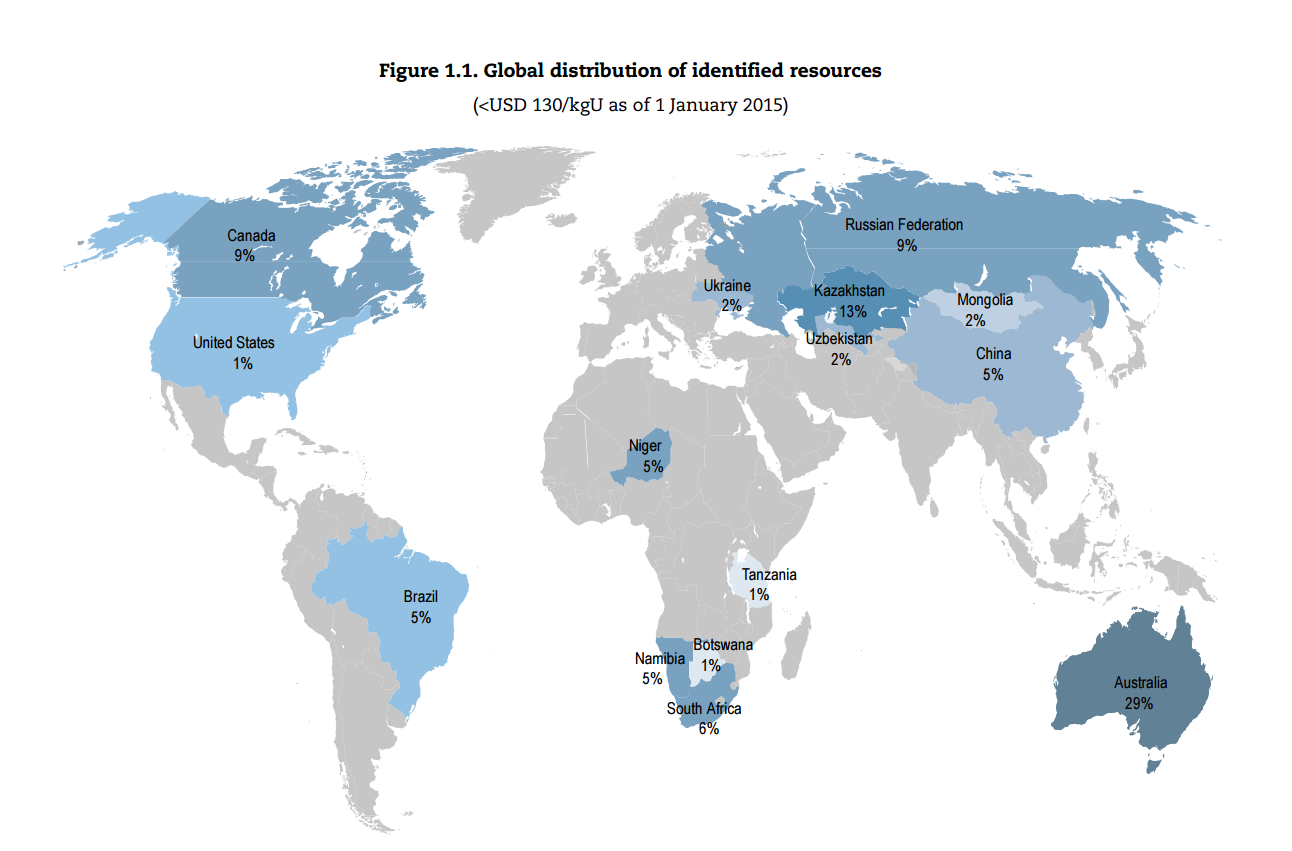Uranium, as touched upon in a previous blog post, is the fuel used for nuclear fission and is primarily obtained through
mining. As an element in the Earth’s crust, uranium is a relatively common
metal on the scale of tin or zinc (Kidd 2011). Throughout the crust, uranium is
found in different concentrations known as ppm (parts per million), which is
how much of a certain rock is uranium. Rocks which have higher ppms will be
given a higher grade and will therefore be more economically viable to exploit.
The viability of the ore-body will also be dependent on the cost of energy
produced from other sources, as a higher energy cost would in turn make more ore-bodies
with lower ppms viable (WNA 2016).
Uranium can be found in various regions around the world,
although are highly concentrated in certain places, with the top 5 countries
having roughly 66% (OECD 2016) of known recoverable resources and just over 75% of
Uranium output (Mining-Tech. 2014). The top dog in terms of uranium resources by far is Australia,
with 29% of total known recoverable reserves, with Kazakhstan, Canada and
Russia each having a respectable 13-9% each (WNA 2016). This spread of uranium reserves
across the global and political landscape would mean it would be hard to truly
blockade a country from accessing uranium to feed its nuclear intent.
 |
| Global distribution of Uranium in the top 15 countries (OECD 2016) |
 |
| Uranium per Country with Cost (WNA 2016) |
The big questions are how much uranium is there? And how long will the uranium last? This is mainly measured from the price of extracting said uranium, as some ore-bodies will cost more to extract. At a price of USD 130/kg and less, there is predicted to be 5.7 million tons of identified uranium that can be mined (OECD 2016), which if matched up with the 2006 uranium requirements of 66,500 tons, which would last roughly 85 years (Chmielewski 2008). Different sources using slightly different values calculate 80 years and 90 years of Uranium supply left at this price (Kidd 2011) (WNA 2016). These calculations are based on a scenario that nuclear energy doesn't really change going into the future, and a whole range of different scenarios could increase or decrease viable reserves. A decrease would only likely come about if the overall cost of producing energy decreased to a point, that nuclear energy was being priced out by other energy sources. If prices dropped to a point where only uranium mined at a price of USD 80/kg or less was viable, then only 37% of the 5.7 million tons mentioned earlier, would be able to be mined (OECD 2016). Increases of viable reserves could be caused by a number of things; simply an increase in the price of energy would allow more orebodies to be mined that were once too expensive. Discovery of further uranium resources from geological predictions will of course increase supply, with (Chmielewski 2008) estimating that we would have enough Uranium to last 300 years. Recycling plutonium from spent fuel cells could increase the life of today’s known uranium supply by 70 times, which would mean the reserves could last up 3000 years! Technological advances also have the capability to reduce mining costs and extend the life of fuel cells, with the new Generation-IV fast neutron reactors with their closed fuel cycle producing 100 times the energy with the same quantity of uranium (Chmielewski 2008). All these factors have the potential to come together, to give us the uranium we need for thousands of years.
 |
| Worldwide uranium resources and potential years of generation (Chmielewski 2008) |
Uranium resources have been increasing significantly since 1975 in correspondence to increased expenditure on exploration. This would suggest that as exploration increases, viable reserves of uranium would also increase, with previously uneconomic uranium from Florida once again being examined for possible extraction, and lower-grade ore bodies such as those in Morocco also being investigated (Kidd 2011). This is because, the uranium fuel only makes up a fraction of the cost of nuclear energy; only 2% of the cost is attributed to the uranium, with the vast majority attributed to building the plant, operating and maintenance. This means that a theoretical doubling of uranium prices would only add a 2% increase on to final electricity bills (Chmielewski 2008).
 |
| Known Uranium Resources, their prices and Exploration Expenditure (WNA 2016) |
As technology advances and additional orebodies become
viable and are discovered, it appears that reserves of uranium will be around
for thousands of years to come if managed correctly. This could pave the way to
an era of cleaner energy if managed correctly. This is dependent on the
research and exploration being done however, which may be at risk from
investment as recent discoveries of cheap shale have the potential to side-track
nations away from uranium exploration. Or there is the potential that uranium may
not be needed at all by 2050, with hopeful estimates that we could have nuclear
fusion power plants in operation by then!
No comments:
Post a Comment